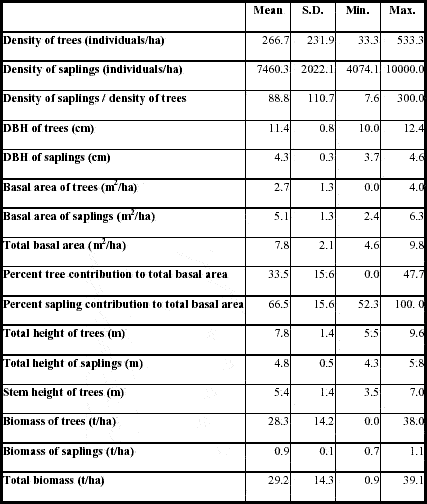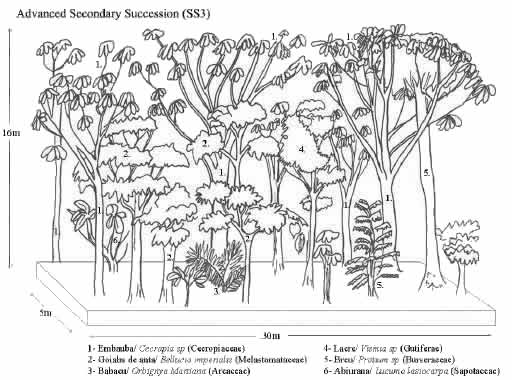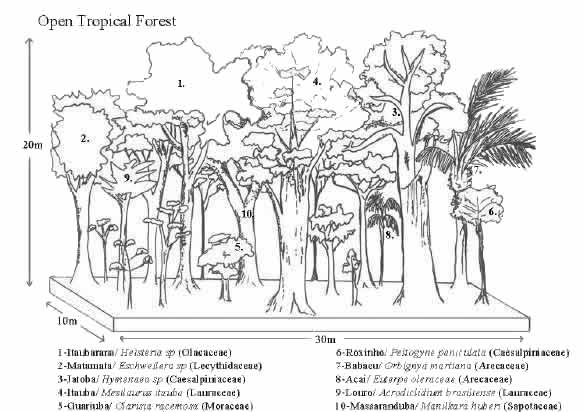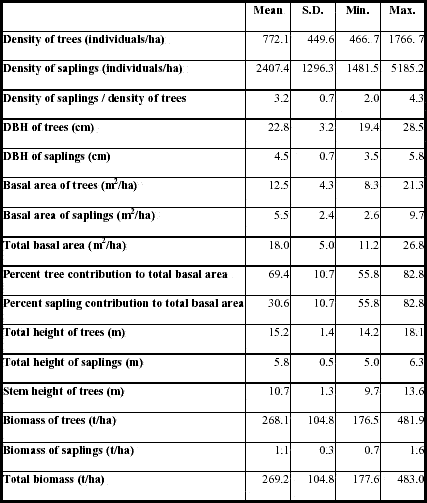![]()
CHAPTER 3 - VEGETATION STRUCTURE AS AN INDICATOR FOR LAND-COVER DYNAMICS ASSESSMENT IN THE AMAZON
3.4. Vegetation structure of secondary succession and forest in Machadinho and Anari
3.4.1. Phyto-physiognomy and general patterns of succession classes and forest
This section describes the main characteristics of each vegetation type sampled during fieldwork (i.e., SS1, SS2, SS3, and forest).
Six sites were sampled to represent SS1. Their ages are three and five years according to information gathered from interviews with landowners. Earlier stages of abandonment (one and two years) were not sampled because of their spectral similarity with other LULC features, such as degraded pasture and perennial agriculture. The discussion about the role of pasture in Amazonian landscapes is an important issue, when related to its different functions in terms of land use or land cover. It is common to see initial stages of secondary succession used for cattle ranching as well as abandoned pastures, where land cover follows the trend of vegetation recovery. To avoid misinterpretation and to keep control over this dichotomy, it was assumed that the percentage ground cover was the variable defining the threshold between the classes 'pasture' and SS1. Thus, areas with grass cover greater than 75% were defined as cultivated pasture. Areas with grass cover between 25 and 75% and used as pasture were assigned as degraded pasture. SS1 was assigned solely to areas where the grass cover was less than 25%, which generally occurs in sites that have been abandoned for more than two years. Each of the six sites sampled has its own history of occupation and abandonment that, together with their different ages and biophysical characteristics, produces an internal variability within the class.
The profile in Figure 14 shows a phyto-physiognomic representation of a SS1 plot. Table 5 summarizes structural characteristics of these sites. Pioneer species such as light-demanding herbaceous plants, grasses, vines, seedlings, and saplings dominate SS1. These species have a short life cycle, high growth rate and high reproductive resource allocation (Gómez-Pompa and Vasquez-Yanes 1981). Some tree species become important after the second or third year of regrowth. Besides palms, species commonly associated with this period include Vismia sp. and Cecropia sp, as illustrated in Figure 14.

Figure 14 - Vegetation profile of an initial secondary succession stand in Machadinho d’Oeste and Vale do Anari.
Table 5 - Vegetation structural variables for initial secondary succession stands in Machadinho d’Oeste and Vale do Anari.

In general, the structural variables show low standard deviation compared to the means, except for density of trees and the ratio between densities of saplings and trees. An important characteristic of this stage is the much higher density of saplings (7460.3 individuals/ha) compared to the density of trees (266.7 individuals/ha). High sapling competition in SS1 is also expressed by its twofold basal area compared to trees. The average DBH for trees is just 1.4 cm above the minimum sampling size (10 cm), indicating the early stage of vegetation recovery. The mean tree height of 7.8 m is relatively high compared to other sites in the Amazon (Tucker et al. 1998). This is due mainly to Cecropia trees competing for light and emerging to form the canopy (Figure 14). Despite the high density of saplings, trees are responsible for the greatest part of total stand biomass, which is 29.2 t/ha (metric tons per hectare)(Table 5).
The sample for SS2 included ten sites with ages of six, eight, nine, and ten years. Figure 15 shows a profile of this vegetation. Table 6 summarizes the calculated structural variables. The physiognomic difference of this stage in relation to SS1 is evident. Saplings are still important for the stand as a whole (density of 4,814.8 individuals/ha), but the density of trees is three times greater than in SS1 (density of 763.3 individuals/ha). DBH for trees increased to an average of 13.8 cm. Total basal area is 11.5 m2/ha. The sapling contribution of 55.6% to total basal area indicates that saplings are still very important at this stage of regrowth. However, the mean height of trees (10.1 m) is now two times greater than for saplings. Biomass increased twofold in relation to SS1 due to the increase in DBH and height of trees.

Figure 15 - Vegetation profile of an intermediate secondary succession stand in Machadinho d’Oeste and Vale do Anari.
Table 6 - Vegetation structural variables for intermediate secondary succession stands in Machadinho d’Oeste and Vale do Anari.

In sum, during SS2, young trees are already present but saplings still have a higher density. A closer canopy alters the microclimate, improving conditions for shade-tolerant tree species and creating an unsuitable environment for pioneer species. This profound change sets the path to a more advanced stage of vegetation regrowth.
Eight sites with ages of twelve and thirteen years represented SS3. It is useful to remember that the study area started to be colonized between 1981 and 1984, the satellite image was acquired in 1998, and fieldwork was done in 1999. This makes it difficult to find older stages of regrowth, with the main source being only records kept by landowners. Figure 16 illustrates a SS3 stand. The structural variables for this class are described in Table 7.

Figure 16 - Vegetation profile of an advanced secondary succession stand in Machadinho d’Oeste and Vale do Anari.
Table 7 - Vegetation structural variables for advanced secondary succession stands in Machadinho d’Oeste and Vale do Anari.

There are clear differences in vegetation structure. Although large Cecropia are still present, most pioneer species gave way to slow-growing, shade-tolerant forest species. Trees dominate the stand as also pointed out by previous studies (Li et al. 1994, Tucker 1996). Tree density increased to 920.8 individuals/ha while density of saplings decreased to 3,750.0 individuals/ha. Average DBH for trees is 17.1 cm and basal area results are now slightly greater for trees than for saplings (6.86 and 6.73 m2/ha, respectively). Total basal area increased to 13.6 m2/ha with a tree contribution of 51.1%. The mean height for trees is 3 m greater than in SS2 stands. Increases in DBH and height doubled the aboveground biomass in relation to SS2. The general appearance of this vegetation type in terms of canopy layers is similar to a forest. However, trees are still not as high or thick, as explained below.
Seven sites represented the sample for open tropical forest. As illustrated in Figure 17, a clear understory and larger trees characterize these areas. The vegetation formation comprises relatively widely spaced tree individuals, sometimes including palms, bamboo, and lianas, as described by Barros-Silva et al. (1978). These authors also reported a shorter Amazonian forest for eastern Rondônia, with height varying around twenty meters.

Figure 17 - Vegetation profile of a tropical open forest stand in Machadinho d’Oeste and Vale do Anari.
The structure of the tropical open forest is quite different from secondary succession stages. Results shown in Table 8 illustrate these findings. The average height is even lower than reported in the literature for other studies: 15.2 m (Barros-Silva et al. 1978, Salomão and Lisboa 1988, Alves et al. 1997). The density of saplings is the lowest of all vegetation classes sampled (2.407,4 individuals/ha). The density of trees (772.1 individuals/ha) is lower than in SS3, certainly because large Cecropia individuals and other pioneer species died off during the transition to forest. The mean DBH of trees (22.8 cm) is five times greater than the mean DBH for saplings (4.5 cm) indicating the dominance of trees in these sites. This characteristic is also depicted from values of basal area. Basal area for trees (12.5 m2/ha) represents 69.4% of total basal area. An ultimate indication about the developed structure of the sampled forests in relation to the secondary succession stands is given by their total biomass of 269.2 t/ha. The importance of trees is also noticed here, as their biomass is 268.1 t/ha. Saplings contribute with just 1.1 t/ha.
Table 8 - Vegetation structural variables for tropical open forest stands in Machadinho d’Oeste and Vale do Anari.

A complementary way to understand differences and similarities between secondary succession stages and forests in the study area is to analyze structural variables in a comparative fashion. The next section is dedicated to this comparison.